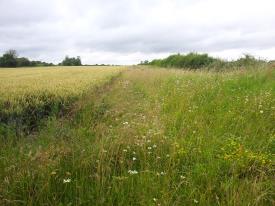 G H Dean & Co Ltd
G H Dean & Co Ltd
Region: Kent
Farm: Arable, grassland and fruit
Size: 1753 ha
Background
We grow 1075 ha of combinable crops (milling, biscuit and feed wheat, winter OSR, winter beans and spring peas) together with 400 ha of grass including 70 ha short term leys and permanent pasture under Stewardship management mainly along the Swale Estuary and Conyer Marshes. This area supports a flock of 1500 Suffolk and Kent Romney ewes. We also grow 175 ha of fruit. Our soils are very variable with some good loamy brickearth, flinty clay cap leading up to the Downs and silty clay on the Marshes.
What environmental management do you already undertake on your farm?
Our Stewardship grassland is in EK2 / EK3 (low/very low input) and HK10 (winter waders and wildfowl) and HK 15 (grassland for target features). Fodder crops of brassicas are grown under the management prescriptions of HG6. Our other ES options are historic buildings, wild bird seed mix, hedges and ditches, field corners, nectar flower mix and beetle banks (1 plus 1 voluntary) and reduced depth cultivation for archaeology. Voluntary measures include stationing bumblebee hotels, and attractant flower and windbreak species in orchards. Farm system based environmental management we do includes non-inversion tillage to boost soil structure, organic matter and earthworm numbers.
How will you be/are you taking part in the Campaign?
As well as ES options, 100 ha of catch and cover crops (vetches and rye after cereals before peas, and oats behind 2nd wheats before peas) are planted in early September and grazed off with replacement ewe lambs over winter before drilling in March. This holds N, adds organic matter and keeps soil live. We are moving to standardised equipment widths to reduce compaction – we’ve seen better soil structure and travelling capability. We also apply 2-3,000 tonnes compost each year. We have water vole and are looking to fence some ditches to improve habitat and linkages, and we have 2 barn owl boxes in place.
Will you be using an adviser?
LEAF
FWAG
Kent Wildlife Trust
Bumblebee Conservation Trust
RSPB
East Malling Research
What are the benefits of taking part in the Campaign?
The sorts of issues that CFE campaigns on are very relevant. For example cover crops; getting soil biology right is very important for us – our crop establishment costs have reduced significantly since the implementation of no-till drilling. And encouraging pollinators – we look to increase production and fruit yield. Encouragement to do field margins and wildflower mixes helps here. Collectively, following best practice eg Metaldehyde stewardship avoids more regulation for the industry.
How does undertaking voluntary management fit in with your farming business?
G H Dean hosts an open farm day that highlights the importance of the role of pollinators on our farm. We like to engage with people who can enhance our business and it’s good to be involved in an exchange of ideas. Ideally we can create areas of habitat for bees and reduce costs. We want to know our soils better, what they need and how this will improve our results.
What is driving you to take part in the Campaign?
It’s about taking a holistic approach - making use of nature and following practices that are soil and wildlife friendly, not just following the farming manual.
To read the full PDF please click here.